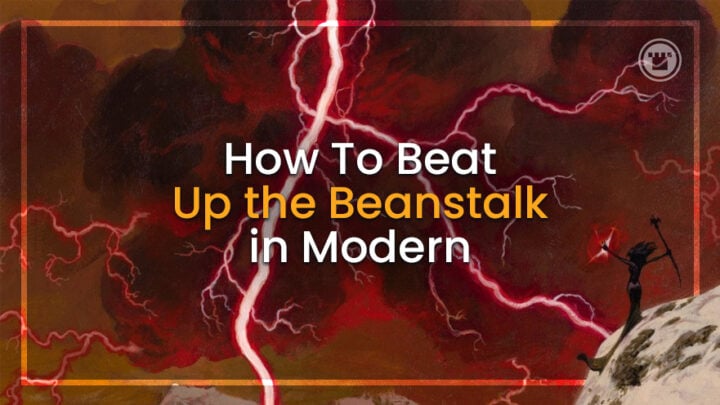A couple of weeks ago, I wrote about how to beat Scam, which was the beat deck in Modern at the time. However, a new challenger has appeared to try and claim that title: Four Color Beans.
If you aren’t playing Beans yourself you’re going to make sure you have a plan for it. And since it’s a new and powerful deck, don’t worry if you don’t know what to play when aiming to beat it. I’ve got you covered!
Knowing the Enemy
In order to beat Beans, we need to know what Beans is and how it differs from traditional, Four Color Omnath.
While the traditional versions of Four Color play Up the Beanstalk for value, the difference here is that Beans really means commits. This evolution often plays eight ways to cascade into Up the Beanstalk, putting the powerful, new enchantment in play as quick and often as possible.
So what is Beans trying to accomplish? The short and the long answer is to dominate other midrange decks by burying them in cards and maintaining firm control of the board.
Up the Beanstalk turbo charges the action economy of the Four Color Omnath shell. Historically, those decks drew a fair amount of cards to make sure they could always pitch cast Solitude and Fury. The elementals are obviously still good without Up the Beanstalk, but pitch-casting them comes with a real cost that other decks could exploit.
The way to fix that is to construct a Four Color Omnath shell with Shardless Agent and Bloodbraid Elf to cascade specifically into Up the Beanstalk. This not only mitigates the chance you won’t find a copy, but it drastically increases the odds you’ll find multiple.
Once two copies of Up the Beanstalk are in play, Solitude and Fury become straight card advantage. It is nearly impossible for other, fair creature decks to win a resource battle when Solitude, Fury and Leyline Binding are all card positive.
So, when it comes to beating Beans, it seems like other midrange decks are at a significant disadvantage. And if you can’t beat Beans in the middle, that leaves two options: go under it or go over it. Luckily there are a couple of reasonable options in whichever direction you prefer.
Amulet
Amulet has a storied history of absolutely blowing up opposing midrange decks through both incredible speed and surprising resilience. Fast Amulet draws can easily present a lethal attack in the first three turns of the game, which doesn’t give Beans the time it really wants to set up.
Due to the explosive nature of Amulet, Beans will often have to hold up mana for Leyline Binding or Ice in the early turns — which makes it harder for them to get an Up the Beanstalk into play to start their own engine.
While Solitude and Leyline Binding are OK at letting you not instantly lose to a Primeval Titan, Amulet is very good at creating a stream of must answer threats. This forces Beans to have a lot of ways to interact.
Then, even if Beans answers all of the Titans and Cultivator Colossus, Amulet can still put together a kill with Valakut, the Molten Pinnacle and Dryad of the Ilysian Grove. Urza’s Saga combined with bounce lands also lets Amulet pump out as many Constructs as they need to finish the job.
At any step, if Beans fails an interaction check, it is incredibly likely the deck loses on the spot. This isn’t to say Beans can’t win a match, but Amulet is a solid favorite. Amulet also gets bonus points for having a strong Scam matchup as well!
Tron
The big mana trend continues, as it is the best way to go over the top of the Beans matchup. Again, Beans is trying to cascade into Up the Beanstalk on turn three and then start generating an advantage.
Meanwhile, on turn three, Tron is playing a Karn, the Great Creator or The One Ring. In the battle between the two decks that don’t do much until turn three, Tron’s payoffs win a heads up fight against the midrange value engine of the Beans deck.
Yes, Leyline Binding is good at answering Tron’s threats — but it doesn’t do it cleanly. All of the planeswalkers get an activation off while Ulamog and Sundering Titan have powerful enter the battlefield abilities.
Tron isn’t without answers to Binding, either, as Boseiju and Oblivion Stone can free Tron’s powerful threats from an enchantment-heavy deck. Tron actually fills a similar role as Beans by beating up on the midrange decks of Modern, but Beans gets played because it doesn’t have as polarized a matchup spread as Tron does.
Burn
Now that we’re done with the heavy hitters, we’re into decks that try to knock the Beans deck off balance early and often, keeping them on the back foot long enough to end the game quickly. Burn is a premier choice to get underneath the Beans deck because it can easily win games with just non-creature spells. This is important because decks that rely on the combat step often find themselves at a disadvantage against the removal-dense Beans deck.
At the moment, the popular build of Beans isn’t playing any form of counter magic, which means Burn has free reign to resolve its spells. Without being able to interact with any spells, Burn will win on turn four. That means Beans needs to try and either win before that or find a way to set up Omnath, Locus of Creation with enough lands to run the Burn deck out of gas. But Roiling Vortex effectively turns off Omanth while also making Solitude and Fury incredibly punishing to pitch cast.
Simply put, Burn just lines up well against Beans — especially since they have reduced their creature count, making many of the Beans cards worse in the matchup.
Hammer
Hammer functions similar to Amulet, but instead of generating a ton of mana to explode past Beans, the deck cheats on the equip cost of Colossus Hammer to end the game incredibly quickly from a low base.
The strength of Hammer is it turns every creature in the deck into a lethal threat, which means a lot of Solitudes are going to end up pointed at Ornithopters — allowing the Hammer player to sculpt a winning situation with Puresteel Paladin.
Hammer can often force the Beans deck to interact before they get any copies of Up the Beanstalk into play, which means Hammer can get ahead on cards if their opponent has to pitch cast Solitude or Fury to avoid getting run over.
Meanwhile, much like Amulet, Hammer can pivot to a very powerful Urza’s Saga plan, making some of the biggest Constructs in Modern. Lavinia, Azorius Renegade and Surge of Salvation also make it very difficult for the Beans deck to interact on key turns by forcing them to have a second removal spell in the same turn, or the game likely ends.
Spell Pierce drops off as the game goes on due to the cost reduction on Leyline Binding, but it will likely counter something in the early turns of the game allowing Hammer players to steal a quick one.
End Step
If you’re playing Regional Championship Qualifiers and for whatever reason don’t want to play Beans yourself, you’ll need a plan to combat it. Thankfully many of these decks have a good Scam matchup as well if trying to exploit the metagame is your plan.
Even still, I’d recommend playing Scam or Beans if you’re trying to win — but a lot of decks in Modern have the capability to win smaller tournaments. These are some of the best decks to do it with if the matchup odds are in your favor.
As always you can find me on Twitter @RappaciousOne and on BlueSky at @RappaciousOne.bsky.social for questions, comments and feedback. As always, I hope your next tournament goes well, and I’ll see everyone back here next week!

Michael Rapp is a Modern specialist who favors Thoughtseize decks. Magic sates his desire for competition and constant improvement.






